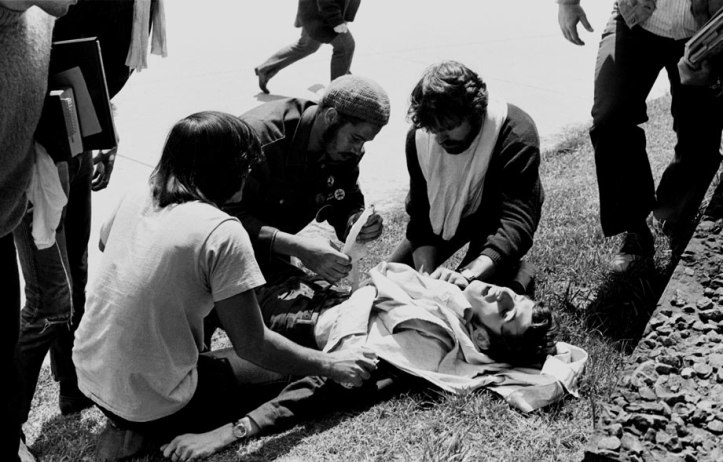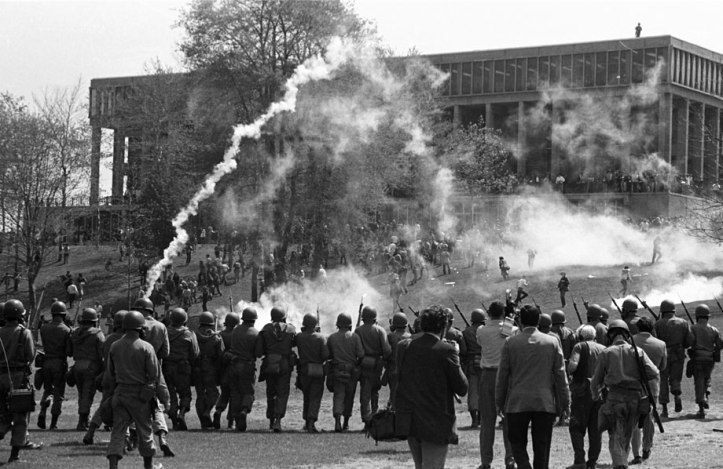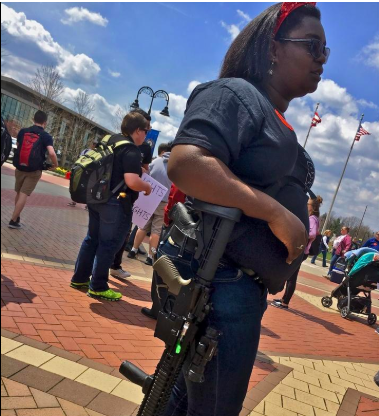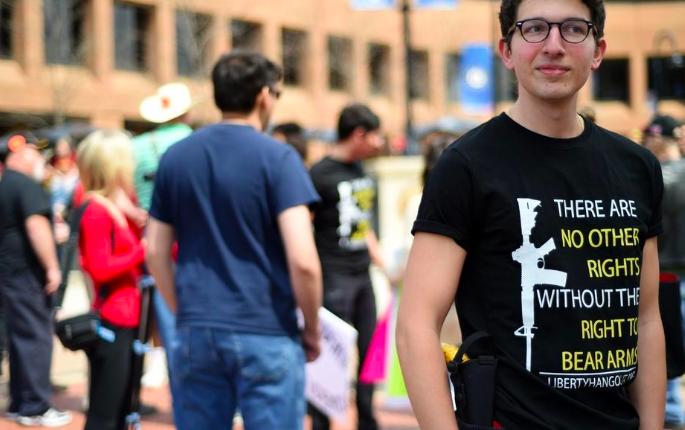04 May 2018 | Various Sources | Hawkins Bay Dispatch
“Tin soldiers and Nixon’s coming / we’re finally on our own / this summer I hear the drumming/ four dead in Ohio.” Neil Young, lyrics, “Ohio” Kent State
The Kent State shootings (also known as the May 4 massacre or the Kent State massacre) were the shootings on May 4, 1970 of unarmed college students by members of the Ohio National Guard at Kent State University in Kent, Ohio during a mass protest against the bombing of Cambodia by United States military forces.
Twenty-eight guardsmen fired approximately 67 rounds over a period of 13 seconds, killing four students and wounding nine others, one of whom suffered permanent paralysis. [Wikipedia]

4 Kent State Students Killed by Troops
05 May 1970 | John Kifner | New York Times
KENT, Ohio, May 4—Four students at Kent State Univer sity, two of them women, were shot to death this afternoon by a volley of National Guard gun fire. At least 8 other students were wounded.
The burst of gunfire came about 20 minutes after the guardsmen broke up a noon rally on the Commons, a grassy campus gathering spot, by lob bing tear gas at a crowd of about 1,000 young people.
In Washington, President Nixon deplored the deaths of the four students in the follow ing statement:
“This should remind us all once again that when dissent turns to violence it invites tragedy. It is my hope that this tragic and unfortunate in cident will strengthen the de termination of all the nation’s campuses, administrators, fac ulty and students alike to stand firmly for the right which exists in this country of peace ful dissent and just as strongly against the resort to violence as a means of such expres sion.”
In Columbus, Sylvester Del Corso, Adjutant General of the Ohio National Guard, said in a statement that the guardsmen had been forced to shoot after a sniper opened fire against the troops from a nearby rooftop and the crowd began to move to encircle the guardsmen.
Frederick P. Wenger, the As sistant Adjutant General, said the troops had opened fire after they were shot at by a sniper.
“They were under standing orders to take cover and re turn any fire,” he said.
This reporter, who was with the group of students, did not see any indication of sniper fire, nor was the sound of any gunfire audible before the Guard volley. Students, con ceding that rocks had been thrown, heatedly denied that there was any sniper.
Gov. James A. Rhodes called on J. Edgar Hoover, director of the Federal Bureau of Investi gation, to aid in looking into the campus violence. A Justice Department spokesman said no decision had been made to in vestigate.
At 2:10 this afternoon, after the shootings, the university president, Robert I. White, or dered the university closed for an indefinite time, and officials were making plans to evacuate the dormitories and bus out of‐state students to nearby cities.
Robinson Memorial Hospital identified the dead students as Allison Krause, 19 years old, of Pittsburgh; Sandra Lee Scheuer, 20, of Youngstown, Ohio, both coeds: Jeffrey Glenn Miller, 20, of 22 Diamond Drive, Plain view, L. I., and William K. Schroeder, 19, of Lorain, Ohio.
At 10:30 P.M. the hospital said that six students had been treated for gunshot wounds. Three were reported in critical condition and three in fair con dition. Two others with super ficial wounds were treated and released.
Students here, angered by the expansion of the war into Cambodia, have held demon strations for the last three nights. On Saturday night, the Army Reserve OOfficers Train ing Corps building was burned 10 the ground and the Guard was called in and martial law was declared.
Today’s rally, called after night in which the police and guardsmen drove students into their dormitories and made 69 arrests, began as students rang the iron Victory Bell on the commons, normally used to herald football victories.
A National Guard jeep drove onto the Commons and an of ficer ordered the crowd to dis perse. Then several canisters of tear gas were fired, and the students straggled up a hill that borders the area and retreated into buildings.
A platoon of guardsmen, armed—as they have been since they arrived here with loaded M‐1 rifles and gas equipment— moved across the green and over the crest of the hill, chas ing the main body of pro testers.
The youths split into two groups, one heading farther downhill toward a dormitory complex, the other eddying around a parking lot and girls’ dormitory just below Taylor Hall, the architecture building.
The guardsmen moved into a grassy area just below they parking lot and fired several canisters of tear gas from their short, stubby launchers.
Three or four youths ran to the smoking canisters and hurled them back. Most fell far short, but one landed near the troops and a cheer went up from the crowd, which was chanting “Pigs off campus” and cursing the war.
A few youths in the front of the crowd ran into the park ing lot and hurled stones or small chunks of pavement in the direction of the guardsmen. Then the troops began moving back up the hill in the direction of the college.
Students Cheer
The students in the parking lot area, numbering about 500, began to move toward the rear of the troops, cheering. Again, a few in front picked up stones from the edge of the parking lot and threw them at the guardsmen. Another group of several hundred students had gathered around the sides of Taylor Hall watching.
As the guardsmen, moving up the hill in single file, reached the crest, they suddenly turned, forming a skirmish line and opening fire.
The crackle of the rifle volley cut the suddenly still air. It appeared to go on, as a solid volley, for perhaps a full min ute or a little longer.
Some of the students dived to the ground, crawling on the grass in terror. Others stood shocked or half crouched, ap parently believing the troops were firing into the air. Some of the rifle barrels were pointed upward.
Near the top of the hill at the corner of Taylor Hall, a stu dent crumpled over, spun side ways and fell to the ground, shot in the head.
When the firing stopped, slim girl, wearing a cowboy shirt and faded jeans, was lying face down on the road at the edge of the parking lot, blood pouring out onto the macadam, about 10 feet from this reporter.
Too Shocked to React
The youths stood stunned, many of them clustered in small groups staring at the bodies. A young man cradled one of the bleeding forms in his arms. Several girls began to cry. But many of the stu dents who rushed to the scene seemed almost too shocked to react. Several gathered around an abstract steel sculpture in front of the building and looked at a .30‐caliber bullet hole drilled through one of the plates.
The hospital said that six young people were being treat ed for gunshot wounds, some in the intensive care unit. Three of the students who were killed were dead on arrival at the hospital.
One guardsman was treated and released at the hospital and another was admitted with heat prostration.
In early afternoon, students attempted to gather at various area of the Commons but were ordered away by guardsman and the Ohio Highway Patrol, which moved in as reinforce ments.
There were no further clashes, as faculty members, graduate assistants and stu dents leaders urged the crowd to go back to the dormitories.
But a bizarre atmosphere hung over the campus as Guard helicopter hovered over head, grim‐faced officers ma neuvered their men to safeguard the normally pastoral campus and students, dazed, fearful and angry, struggled to comprehend what had happened and to find something to do about it.
Students carrying suitcases and duffel bags began leaving the campus this afternoon. Early tonight the entire campus was sealed off and a court in junction was issued ordering all students to leave.
A 5 P.M. curfew was de clared in Kent, and road blocks were set up around the town to prevent anyone from enter ing. A state of emergency was also declared in the nearby towns of Stow and Ravenna.
Statement by General
KENT, Ohio, May 4 (UPI)— Brig. Gen. Robert Canterbury, the commander of Guard troops on the Kent State campus, said today that no warning had been given to the students that the troops would shoot.
General Canterbury, at campus news conference, said in reply to questioning that no official order had been given to open fire.
“The situation did not allow it,” he said. “The emotional atmosphere was such that any thing could have happened. It was over in two to three seconds.”
He said a guardsman “always has the option to fire if his life is in danger.”
“A crowd of about 600 stu dents had surrounded a unit of about 100 guardsmen on three sides and were throwing rocks at the troops,” he said. “Some of the rocks were the size of baseballs. The troops had run out of tear gas.”
Governor Rhodes, who had ordered the National Guards men onto the campus Saturday after students began looting; stores and breaking windows in the downtown area, said “a complete investigation” would be made into the shootings.
Dr. White, the university president, said:
“Everyone without exception is horror‐struck by the tragedy of the last few hours. Unfortun ately, no one is able yet to say with certainty what the facts of the situation are.
“There are many unconfirmed reports of gunfire from various sources,” he went on. “We are asking for every possible ap propriate investigation, which we shall undertake to pursue to the limit.”
Father Is Printer
One of the dead victims at Kent State, Jeffrey Glenn Miller, was the son of Bernard Miller, a linotype operator who works in the composing room of The New York Times.





Speaking out: Kent State photographer on iconic photo
THE HISTORY OF ‘OHIO’: CROSBY, STILLS, NASH AND YOUNG’S RAW REMINDER OF THE KENT STATE MASSACRE
On May 4, 1970, National Guardsmen squared off against anti-war demonstrators on the campus of Ohio’s Kent State University. The student protest was sparked by President Richard Nixon’s announcement on April 30 that U.S. troops would invade Cambodia, escalating the already unpopular war in Vietnam.
The deadly confrontation that followed would become known as the Kent State Massacre, and was immortalized in one of rock’s greatest protest songs, “Ohio” by Crosby, Stills, Nash & Young.
The day after Nixon’s Cambodia speech, a few storefronts in the town of Kent were trashed by protesters, and cops used tear gas to disperse the crowd. On May 2, Ohio Governor James Rhodes called in the Guard to restore order. That evening, a Reserve Officer Training Corps (ROTC) building was set on fire as students cheered; guardsmen responded with tear gas and arrested many demonstrators.
Watch: Ohio- Crosby, Stills, Nash and Young
A large protest on the university Commons was planned for May 4. As a few thousand students and spectators gathered, undergraduate John Filo grabbed his camera and headed towards the crowd. Filo, who worked at the Kent State photo lab, hoped to catch a few compelling images of the event.
When protesters refused an order to either disperse or face arrest, guardsmen fired tear gas at the crowd. Many students fled the scene, and the Guardsmen followed them to a football field, where the students pelted the soldiers with rocks.
Shortly after noon, the Guardsmen moved back up a hill, as if to retreat. But when they reached the top, they turned and opened fire on the students with their M1 rifles. In just 13 seconds, anywhere from 61 to 67 rounds were fired and four students lay dead; nine more were injured.
Of the four students killed, only Allison Krause and Jeffrey Miller were part of the demonstration. Sandra Scheuer and William Schroeder were walking to class when they were gunned down. The iconic photograph of 14-year old Mary Ann Vecchio kneeling over the corpse of Jeffrey Miller would bring the Vietnam War home to America and win Filo the Pulitzer Prize.
“Blood was just pumping out of his body, on the hot asphalt,” Filo told Annenberg Digital News. Then he spotted Vecchio. “I could see the tension building in this girl and finally she let out with the scream, and I sort of reacted to the scream and shot that picture.”
Days later, David Crosby handed Neil Young a copy of Life magazine that featured Filo’s photo. Until then, CSNY were known for the gentle lyrics and intricate harmonies in songs like “Our House” and “Teach Your Children.” But Crosby told VH1 that Filo’s photo inspired the raw emotions of “Ohio.” “That girl leaning over the other kid in a pool of blood, and a look of, ‘Whaaa? What? How could this have happened?’ You know it’s shock … grief.”
“Crosby came and had the magazine with the Kent State killings,” said Young. “I had heard it on the news, what had happened, but Crosby always had a way of bringing stuff into focus.”
Young disappeared into the woods with his guitar. When he returned a few hours later, he’d written “Ohio.”
“Crosby called me up and said he’d booked a studio,” bandmate Graham Nashrecalled in MusicRadar. “‘Neil just wrote this song, it’s f—ing fantastic. Get down here.’ Neil played me ‘Ohio,’ and it was ‘Holy f— – fantastic.’ We recorded it in an hour and a half.”
The B-side, Stephen Stills’ “Find the Cost of Freedom,” was recorded in a half-hour and the master was sent to Atlantic Records president Ahmet Ertegun. “We mixed it, gave him the two-track and said, ‘Ahmet, we want this out now,’” Nash remembered. “Ahmet put up an argument, but we were firm. Twelve days later, we put it out in a single sleeve with a copy of the Constitution that had four bullet holes on it.”
“The mood was just very intense,” engineer Bill Halverson related on his website. “They were bent on getting it right and were on a mission.”
Though Young would later write “Rockin’ in the Free World,” which criticized President George H.W. Bush, and “Southern Man,” which skewered that region’s racism, “Ohio” would be the singer’s first protest song.
“It’s still hard to believe I had to write this song,” Young, a Canadian, explained in the liner notes of his Decade anthology. “It’s ironic that I capitalized on the death of these American students. Probably the biggest lesson ever learned at an American place of learning.”
Explicit lyrics like “Tin soldiers and Nixon’s coming … Soldiers are gunning us down … Four dead in Ohio” would get the song banned on some mainstream AM stations but airplay on FM and underground radio would make “Ohio” a Top 20 hit. “For me, ‘Ohio’ was a high point of the band, a major point of validity,” Crosby wrote in the liner notes of the CSN collection. “There we were, reacting to reality, dealing with it on the highest level we could – relevant, immediate. It named names and pointed the finger.”
On May 4, 1997, Crosby, Stills & Nash attended a commemoration of the shootings at the Kent State campus. “Four young men and women had their lives taken from them while lawfully protesting this outrageous government action,” Nash stated. “We are going back to keep awareness alive in the minds of all students, not only in America, but worldwide… to be vigilant and ready to stand and be counted … and to make sure that the powers of the politicians do not take precedent over the right of lawful protest.”
At the end of the ceremony, the trio performed “Ohio” to an enthusiastic crowd.
“The students stood up for their God-given right to protest, and they got slaughtered for it,” Crosby told the Akron Beacon Journal. “Those people were expressing their constitutional right of assembly and were attacked for it, and they’ve never been apologized to.”
Though eight Guardsmen were indicted by a federal grand jury, criminal charges were dismissed in 1974. The Guardsmen testified that they feared for their lives and fired in self-defense.
Open-carry advocates engage Kent State community at event
By Briana Barker / Reporter – The Record Courier Apr 27, 2018

KENT — About 40 gun owners brought handguns, AR-15s and other firearms to the Kent State University campus Friday for an open carry event.
Kent State University Open Carry/Firearms Liberty Outreach was organized by KSU student Kaitlin Bennett, president of the Liberty Hangout club, and by open-carry activist Jeffry Smith.
“Guns save lives,” “you need the government’s guns to take mine,” ”#Endguncontrol” and myriad other phrases were written in chalk around Risman Plaza on campus, and participants carried signs.
Smith has hosted nine open carry events at universities across Ohio and Kentucky. Bennett recruited Smith to help after the similar event on campus in 2016. Smith said he hopes to spread the message that not all gun owners want to preach to others.
“The negative caricatures of the people here are not true,” he said of the gun-carrying crowd. “These people are ready, willing and able to engage in conversation whether you agree or disagree with them about gun rights.”
Bennett said she could not be happier about the turnout for the event, which was intended to spur conversation about gun rights and the Second Amendment.
“I chose to do it on campus because students aren’t allowed to open carry on campus,” Bennett said. “However if we bring guests who can open carry, they are right there, you can easily identify a gun owner and easily have a conversation with them and have questions answered.”
Gun rights advocate Jeffry Smith and Kent State senior Kaitlin Bennett held an open carry event at Risman Plaza on Kent State’s main campus Friday afternoon. The event went on without incident despite local residents opposing it on social media.
Eric Mansfield, Kent State spokesman, said the university has worked with the group before to hold another open carry event and “the group has been cordial and professional.”
While there seemed to be some social media backlash and opposers who said they intended to protest the event, things remained peaceful on the plaza. Bennett said she was surprised there wasn’t a more vocal opposition but was happy to see opposers mingling in the crowd.
“I am so happy to see that they are talking to people, they are mingling, they are walking around, and nothing’s happening,” Bennett said. “This is a perfect example that gun owners are responsible and citizens carrying weapons are safe.”
An increased police presence around Risman Plaza was visible, but the officers stood back while the event carried on. Smith provided safety guidelines for participants to follow before the event, such as long guns must be carried with a sling and carried with an empty chamber with the safety on.
The group required sidearms (handguns, revolvers) to be holstered at all times, in a holster that covered the trigger, and were not permitted to be touched by anyone but the gun owner. Kent State students were not permitted to carry guns, as it would be a violation of the university’s policy; however, Bennett invited Kent students to participate with empty holsters, such as the one she sported for the event.

Princess Kuevor said she found out about the event through Smith and wanted to erase the stigma that minorities don’t carry guns, or are criminals if they do. She said empowering women was another goal.
“I am often the only black woman at a lot of open carry events,” she said. “I think it’s really unfortunate because a lot of women should be carrying and taking self-defense classes … I like to show women that you can be empowered too.”
She said police can’t protect people all the time, and in fact can only respond after an event has occurred.
Kent resident Ted Moisio said gun control is a “double-standard.”
“It’s like the incident in Canada the other day where the guy drove a van into a crowd,” Moisio said. “They are going after the guy, not the van. So why go after the guns?”
![]()
